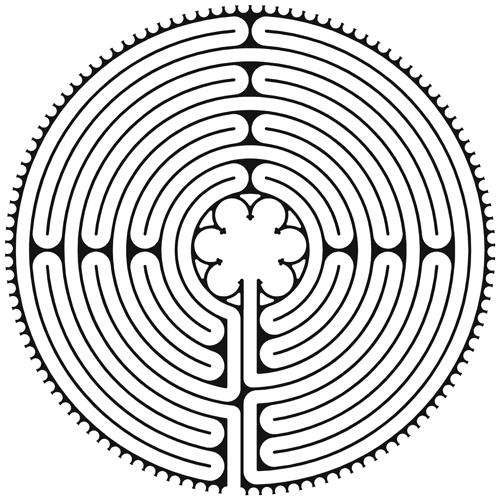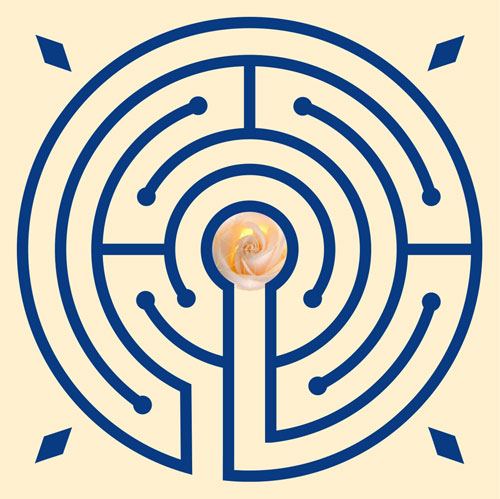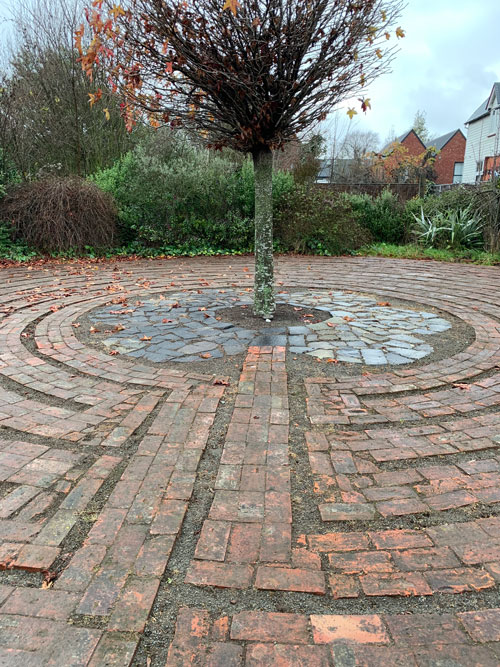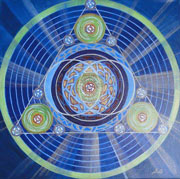This is a partially restored Medieval style labyrinth at the old St Luke’s Church site at 250 Manchester Street, Christchurch. It is made of bricks from a previous church. It is permanently open.
Check the Facebook page for guided walks, and full moon gong sound baths.
A labyrinth is a pattern marked on the ground or floor that is walked as an aid to reflection and meditation. While not specifically Christian in origin or in contemporary use, it has ancient roots as a tool for developing Christian spirituality. A labyrinth has only one path and is not a maze. You cannot get lost in a labyrinth. The journey generally consists of three parts – the journey in, being at the centre, and the journey out.
The labyrinth is viewed as a metaphor for life’s journey. It offers lessons as we walk the path. Walking the labyrinth assists us to address challenges, meditate, pray, and find peace and serenity.
Labyrinths have been around for 4000 years, but the main interest in them comes from the Labyrinth at Chartres Cathedral in France. After a fire, the Cathedral was rebuilt in 1201, in a high Gothic style, with beautiful architecture, exquisite stained glass windows, and an elaborate labyrinth.
The Labyrinth there was not used for centuries, and was covered with rows of chairs, until Rev Dr Lauren Artress visited in the early 90s, with parishioners from Grace Cathedral in San Francisco. She pushed the chairs back and walked the labyrinth there. Lauren brought Labyrinth walking to the English speaking world, and started the organisation Veriditas (after Hildegard of Bingen’s word for “greening”, Viriditas.) Now many groups go on pilgrimage to Chartres Cathedral and walk the Labyrinth there.
The Labyrinth has become a world wide phenomenon, an idea whose time has come.
Many people are walking the Labyrinth all over the world, there is Facilitator training, a World Wide Labyrinth Locator, and a World Labyrinth Day. (Incidentally, in May, the first walk in the world for World Labyrinth Day was at the St Luke’s Labyrinth!)
Labyrinths are in Churches, schools, universities, communities, hospitals and clinics. They are permanent, portable (on canvas), temporary (such as with fabric or rope), or ephemeral (on sand).
Based on the circle, the universal symbol for unity and wholeness, the labyrinth sparks the human imagination and introduces it to a ... patterning that builds a sense of relationship: one person to another, to another, to many people, to creation of the whole.
It enlivens the intuitive part of our nature and stirs within the human heart the longing for connectedness and the remembrance of out purpose for living.
Lauren Artress
Walking the Labyrinth' has reemerged today as a metaphor for the spiritual journey and a powerful tool for transformation. This walking meditation is an archetype, a mystical ritual found in all religious traditions. It quiets the mind and opens the soul.

Labyrinth at Chartres Cathedral
This is an elaborate 11-circuit labyrinth, often called a Medieval Labyrinth. It has a wheel like design in quadrants. The centre has 6 petals, which have been likened to part of the Lord’s Prayer.
Many Labyrinths world wide have this design.

Labyrinth at The Light House
For my part, when I shifted into my current home after the earthquakes, I set up a Temple, and then a Temple Garden, and then there was a space that was asking to be made into a labyrinth. My labyrinth is small, with a 5 circuit classical design
My hope is to purchase a portable 24 foot canvas labyrinth, in a Chartres design, that can be used in different venues around Christchurch, both indoors and outdoors.

St Luke’s Labyrinth
The Labyrinth at St Luke’s Church is a Chartres style labyrinth, a medieval design with 11 circuits. It is made of bricks from a previous church, and these have been embedded into a solid base. A liquidamber tree is in the centre, and there has been a garden around the perimeter.
It can be classified as a ‘lonely labyrinth’, one that has been not maintained.
A few of us are working to clean up the St Luke’s Labyrinth and garden. We meet on Saturday mornings, weather permitting, and would love for you to join us.
We hope that the Labyrinth could be a central space in Christchurch where people can walk, meditate, pray, and find peace and serenity.
Rose Isbell
Christchurch, New Zealand
June 2022
Resources
About the Labyrinth
https://www.tonymchristie.com/about/the-labyrinth/
Introduction to walking the Labyrinth
https://www.youtube.com/watch?v=o7u80ZLEh3
Summary of book by Lauren Artress Walking a Sacred Path
https://thelighthouse.co.nz/images/pdf/Labyrinth_book_summary_handout.pdf
Labyrinth Restoration and Revival
https://www.veriditas.org/Labyrinth-Restoration
Labyrinth at The Light House
https://roseisbell.nz/labyrinth
Facebook link
https://www.facebook.com/Labyrinth-at-The-Light-House-Christchurch-103116255240843
